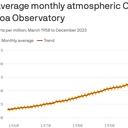Rising CO2 in 2024 poses a threat to Paris warming target

The concentration of carbon dioxide Earth's atmosphere is likely to increase faster this year than the pace needed to limit global climate change to the Paris target of 1.5°C above preindustrial levels, a new analysis finds.
Why it matters: If the planet's warming exceeds that threshold, studies show increasing odds of more devastating climate impacts.
Driving the news: The analysis, from the United Kingdom's Met Office, finds that fossil fuel burning and land use change are overwhelmingly driving the rapid CO2 buildup, with a smaller boost from El Niño-related effects.
- However, the Jan. 19 report found that, even absent an El Niño in the equatorial tropical Pacific Ocean, the annual rate of CO2 increase would reach "the very limits of compatibility with the [Intergovernmental Panel on Climate Change's] 1.5°C scenarios."
- The forecast finds that during 2024, the average annual CO2 concentration at the Mauna Loa Observatory in Hawaii will average about 2.84 parts per million (ppm) higher than 2023's levels. This is the fourth-largest yearly rate of increase since this dataset began in 1958 and would bring the Mauna Loa average to about 423.6 ppm.
- El Niño tends to lead to a faster annual increase in CO2 concentrations due to a drop in the uptake of carbon in tropical land areas.
- A December Met Office analysis found that 2024 could be the first year that the planet exceeds the 1.5°C guardrail for an annual average temperature anomaly. There's a projected range of between 1.34°C and 1.58°C above the preindustrial average.
The intrigue: The new prediction, which is among a slew of climate reports the Met Office puts out each year, compares the projected increase in CO2 concentrations with the increases that would be compatible with the Paris Agreement's 1.5-degree target.
- Each of the 1.5-degree scenarios contained in the most recent U.N. IPCC report shows that the rise in CO2 would need to slow and decrease to zero "urgently" to limit warming to that level.
- The projected rate of 2024's CO2 increase, with the El Niño-related trend removed, would still be well above one of the three IPCC 1.5-degree scenarios. It would also track along the upper end of the uncertainty range of the two others, the analysis shows.
Yes, but: The Met Office's projections can sometimes be off target. For example, 2023's projected growth in atmospheric CO2 levels was far smaller than what actually occurred.
- As the report explains, this is likely due to the unexpectedly early and rapid development of El Niño, which temporarily boosts CO2 growth rates.
- Along similar lines, the El Niño could dissipate more quickly than expected in 2024, lowering the rate of CO2 increase somewhat.
What they're saying: "Scenarios that limit warming to 1.5°C have the CO2 rise stopping by the 2040s and slowing to less than 2 ppm per year in the 2020s — but this year's rise of 2.84 ppm is well above that," said Richard Betts, climate scientist at the UK Met Office and lead author of the new analysis.
- "To halt the CO2 rise, we urgently need to phase out fossil fuel burning and stop deforestation."
- With about 1.3°C (2.34°F) of warming so far, Betts said, the globe is currently on track to hit 1.5°C of warming compared to preindustrial levels in "about 2030 or just after," Betts said.
The backstory: The 1.5-degree target is almost certain to be at least temporarily exceeded. This is known in climate circles as "overshoot," before global temperatures could be brought down again later this century.
- Such a reduction would come through emissions cuts and technological solutions to target legacy emissions in the atmosphere, such as carbon removal.
- But a single year won't mark the crossing of the temperature rubicon. Neither will an individual month or day, and numerous days in 2023 did have a global average surface temperature that exceeded 1.5°C.
- Instead, it refers to a multidecade target.
The bottom line: Earth is reaching global average annual temperatures as well as CO2 concentrations that put the 1.5-degree goal at significant risk. It is a worrying signal about the speed and scale of emissions cuts, technology developments, and more.